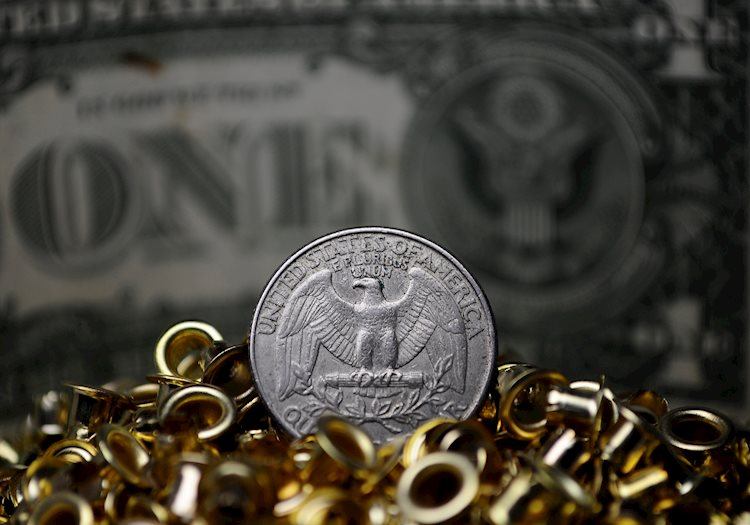- The Greenback is unable to hold on to gains ahead of this week’s close.
- US Traders are absent this Thursday as Thanksgiving and Black Friday will keep US trading desks closed.
- The US Dollar Index breaks below 104 again and is facing a loss for this Thursday and for this week’s performance overall.
The US Dollar (USD) trades sideways to lower with the European trading session halfway through. Although the Greenback held good cards on Wednesday to erase this week’s losses, it saw a near complete reversal in the last trading hour before going into the US bank holiday. With no US trading, Asian and European markets are sending the US Dollar Index (DXY) lower and a weekly loss looks nearly inevitable.
Today sees a very light calendar with no US data to be published. From the European front the Purchase Managers Index (PMI) numbers were already issued ahead of the US PMI numbers for Friday. Although the European numbers are still in contraction, below 50, they are soaring against the previous from October. Should Friday’s US PMI numbers decline, the shift in dynamics between European and US PMI’s could see the Greenback declining further.
Daily digest: Markets on auto-pilot
- European purchasing manager indices numbers are showing an uptick from earlier lower levels in October, with an uptick in November in the preliminary readings.
- The ceasefire deal in Gaza has been delayed by a day, and should take place on Friday.
- A car explosion on the border between Canada and the US was deemed an accident with no terrorist motive at hand.
- The Chinese support and funding issued on Wednesday, made the Chinese property sector jump nearly 7%.
- ECB member Joachim Nagel said in early morning comments that the European Central Bank (ECB) is unsure if it has actually reached its peak rates. Rates must stay higher for longer as inflation might resurge quickly in the coming months.
- Equities are mildly in the green on this US holiday. The Chinese Hang Seng is worth mentioning, up 1% near its closing bell. European equities are looking for direction while US equity futures are marginally higher in their half-day-trading regime due to the US holiday.
- The CME Group’s FedWatch Tool shows that markets are pricing in a 97.8% chance that the Federal Reserve will keep interest rates unchanged at its meeting in December. A juicy sidenote is that now 2.2% even thinks a hike might be at hand.
- The benchmark 10-year US Treasury Note yield halted trading at 4.40% and will not move this Thursday with markets closed.
US Dollar Index technical analysis: Taking a breather
The US Dollar is trading weaker and has erased all its gains from Wednesday. The losses are big enough to tip the US Dollar Index (DXY) into the red this week. With this Thursday’s uptick in European PMI numbers and the US trading desks closed, a window of opportunity could open for another substantial weakening of the US Dollar this Thursday.
The DXY is right at the 200-day SMA near 103.62, and will need to have a daily close above it in order to reassure that the same 200-day SMA is valid as support. Look for a further recovery bounce towards the 100-day SMA near 104.20 with preferably a break and close above. Should the DXY be able to close and open above it later this week, look for a return to the 55-day SMA near 105.71 with 105.12 ahead of it as resistance into next week.
The 200-day SMA will try to play its role again as a crucial pivotal supportive level against any downturn. Should the index snap this level again, the psychological 100.00 level comes into play. With a very slim economic calendar and US trading desks closed, there is room for a potential big downturn.
Fed FAQs
Monetary policy in the US is shaped by the Federal Reserve (Fed). The Fed has two mandates: to achieve price stability and foster full employment. Its primary tool to achieve these goals is by adjusting interest rates.
When prices are rising too quickly and inflation is above the Fed’s 2% target, it raises interest rates, increasing borrowing costs throughout the economy. This results in a stronger US Dollar (USD) as it makes the US a more attractive place for international investors to park their money.
When inflation falls below 2% or the Unemployment Rate is too high, the Fed may lower interest rates to encourage borrowing, which weighs on the Greenback.
The Federal Reserve (Fed) holds eight policy meetings a year, where the Federal Open Market Committee (FOMC) assesses economic conditions and makes monetary policy decisions.
The FOMC is attended by twelve Fed officials – the seven members of the Board of Governors, the president of the Federal Reserve Bank of New York, and four of the remaining eleven regional Reserve Bank presidents, who serve one-year terms on a rotating basis.
In extreme situations, the Federal Reserve may resort to a policy named Quantitative Easing (QE). QE is the process by which the Fed substantially increases the flow of credit in a stuck financial system.
It is a non-standard policy measure used during crises or when inflation is extremely low. It was the Fed’s weapon of choice during the Great Financial Crisis in 2008. It involves the Fed printing more Dollars and using them to buy high grade bonds from financial institutions. QE usually weakens the US Dollar.
Quantitative tightening (QT) is the reverse process of QE, whereby the Federal Reserve stops buying bonds from financial institutions and does not reinvest the principal from the bonds it holds maturing, to purchase new bonds. It is usually positive for the value of the US Dollar.

